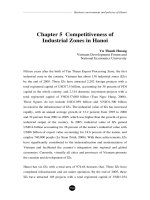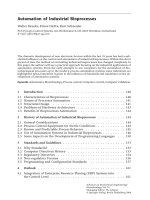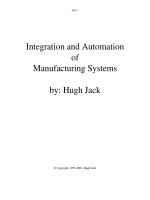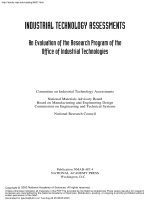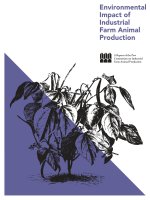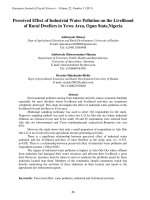Automation of Industrial Bioprocesses
Bạn đang xem bản rút gọn của tài liệu. Xem và tải ngay bản đầy đủ của tài liệu tại đây (248.47 KB, 26 trang )
Advances in Biochemical Engineering/
Biotechnology,Vol. 70
Managing Editor: Th. Scheper
© Springer-Verlag Berlin Heidelberg 2000
Automation of Industrial Bioprocesses
Walter Beyeler, Ettore DaPra, Kurt Schneider
PCS Process Control Systems AG, Werkstrasse 8, CH-8623 Wetzikon, Switzerland
E-mail:
The dramatic development of new electronic devices within the last 25 years has had a sub-
stantial influence on the control and automation of industrial bioprocesses. Within this short
period of time the method of controlling industrial bioprocesses has changed completely. In
this paper, the authors will use a practical approach focusing on the industrial applications of
automation systems. From the early attempts to use computers for the automation of bio-
technological processes up to the modern process automation systems some milestones are
highlighted. Special attention is given to the influence of Standards and Guidelines on the de-
velopment of automation systems.
Keywords.
Automation, Biotechnology, Process control, Computer control, Computer validation.
1Introduction . . . . . . . . . . . . . . . . . . . . . . . . . . . . . . . . 140
1.1 Characteristics of Bioprocesses . . . . . . . . . . . . . . . . . . . . . . 140
1.2 Nature of Processes Automation . . . . . . . . . . . . . . . . . . . . . 141
1.3 Structural Design . . . . . . . . . . . . . . . . . . . . . . . . . . . . . 141
1.4 Problems ofHardware Architecture . . . . . . . . . . . . . . . . . . . 143
1.5 Benefits of Bioprocesses Automation . . . . . . . . . . . . . . . . . . 144
2 History of Automation of Industrial Bioprocesses . . . . . . . . . . . 144
2.1 General Considerations . . . . . . . . . . . . . . . . . . . . . . . . . . 144
2.2 Process Control Equipment for Sterile Conditions . . . . . . . . . . . 144
2.3 Known and Predictable Process Behavior . . . . . . . . . . . . . . . . 145
2.4 Use of Automation Systems in Industrial Bioprocesses . . . . . . . . . 146
2.5 Some Aspects on the Development of Programming Languages . . . 150
3 Standards and Guidelines . . . . . . . . . . . . . . . . . . . . . . . . . 153
3.1 Why Standards? . . . . . . . . . . . . . . . . . . . . . . . . . . . . . . 153
3.2 Computer Directives History . . . . . . . . . . . . . . . . . . . . . . . 153
3.3 Regulatory Directives . . . . . . . . . . . . . . . . . . . . . . . . . . . 154
3.4 Non-regulatory Forums . . . . . . . . . . . . . . . . . . . . . . . . . . 156
3.5 Programming and Configuration Standards . . . . . . . . . . . . . . 157
4Outlook . . . . . . . . . . . . . . . . . . . . . . . . . . . . . . . . . . . 161
4.1 Integration of Enterprise Resource Planing (ERP) Systems into
the Control Level . . . . . . . . . . . . . . . . . . . . . . . . . . . . . . 161
4.2 Ethernet-Based Device-Level Networks . . . . . . . . . . . . . . . . . 162
4.3 A Trend in the Future? . . . . . . . . . . . . . . . . . . . . . . . . . . . 162
References . . . . . . . . . . . . . . . . . . . . . . . . . . . . . . . . . . . . 163
1
Introduction
1.1
Characteristics of Bioprocesses
In the context of this study, the spectrum of bioprocesses is restricted to trans-
formations of substances by microorganisms or cells in submersed cultures on
an industrial scale to achieve one or more of the following goals: 1) degradation
of complex substances into simple components, 2) synthesis of substances
which may be accumulated in the microorganisms or excreted to the medium,
3) production of biomass from some nutrients. Usually the processes run in
some kind of bioreactor to guarantee more or less homogeneous conditions
and to perform the mass transfer of gaseous components creating the necessary
turbulence.
Depending on the characteristics of the process and on the set goals, the pro-
cess is carried out under sterile or non sterile conditions as a batch or con-
tinuous cultivation of one or more strains, the latter running in a stationary or,
in some limits, in a non-stationary state. The different types of bioprocesses
have different control requirements. A large-scale continuous culture for yeast
production running in a stationary state is easily controlled by some param-
eters, such as temperature, pH, aeration and dilution rate; there is no demand
for any logistics. In biological wastewater treatment running under continuous,
non-stationary conditions, decisions are made depending on the highly variable
input substances or on various maintenance requirements. Some type of logical
reasoning has to be introduced into process control.
The two examples mentioned above would not justify a distinction between
the control of a bioprocess and any other chemical process. However, regarding
typical biological batch processes in the field of pharmaceutical production,
running under rigorous sterile conditions, e.g., the production of insulin, inter-
feron or vaccines, a high degree of complexity and special requirements justify
a distinct discipline to describe the control of biotechnological processes. These
processes consist normally of 5 main phases:
– equipment check,
– sterilization,
– cultivation,
– downstream,
– cleaning.
The plant itself is composed of dozens of piped vessels, hundreds of control
loops, thousands of valves and many additional devices. The process is hardly
in a stationary state and the setting of the entire periphery has to follow a recipe
140
W. Beyeler et al.
for the specific product. Exception states and alarm situations have to be
mastered to protect human lives and costly equipment. Additionally, the valida-
tion of pharmaceutical processes and legal prescriptions requires sophisticated
documentation describing all the details of each batch. In a modern biotechno-
logical plant such processes run automatically.
1.2
Nature of Processes Automation
Today, automated devices are found in everyday life. From the standpoint of
common sense, men are replaced by machines in automated systems. In earlier
times automation was based on mechanics, as for example an electric piano, a
machine fed by a program punched on paper rolls replaced the pianist. Rows of
holes are scanned sequentially producing the time axis and depending on the
row position an actuator was activated. Every activation turned the playing on
or off. This simple example shows the basic characteristics of an automatic
process: The system consists of an information processing machine com-
municating with a user (start/stop knobs), a process interface (driver of the
piano hammers) and a program (punched paper rolls) evaluated stepwise.
Depending on the automatic process the information processing is uni- or bi-
directional. Therefore,the automated process can take into account process data
inputs or establish a dialog with the user.
The basic element in automation is the control loop used to adjust an actual
value to a given setpoint automatically. The feedback mechanism introduced by
control loops is of primary importance for technical processes and, in industrial
process control, many of these basic elements are needed. Like any automation,
the control loop consists of a set of inputs, outputs and a program, however cer-
tainly on a level of lower complexity compared to the control of a whole process.
The possibility to structure process control into different hierarchical levels is
of primary importance, as will be explained in the next section.
1.3
Structural Design
Regarding the previous examples of pharmaceutical production, processes are
composed of thousand of devices, the implementation of automation is only
possible on the basis of a well-established structure using a system of one or
more computers including process and user interfaces, program libraries and
data bases. The list of process interfaces defines all of the I/O-channels available
between the process control system and process field. The operations that can
be accomplished have to be functionally described at least in three hierarchical
levels:
Control Level 1.
At the lowest level, I/O-Channels are grouped together to control
loops, as for example the control of temperature, pressure, gas and fluid flow or
pH-value. Control is realized by looping step-function sequences representing
in most cases a PID-algorithm with a constant scanning interval. Therefore the
Automation of Industrial Bioprocesses
141
computer has to guarantee a deterministic time behavior otherwise the PID-
algorithms will not work correctly. The control loops can be switched on and off
by the operator using the user interface. If the user interface allows the setting
of all the outputs and displays all the inputs, the process could be run “by hand”
switching on and off the respective control loops or output devices and ad-
justing the setpoints to the required values. This level is called DDC-level
(Direct Digital Control).
Control Level 2.
The next higher level defines logistic autonomous process units
with the capability of performing a set of operations. Process units may be re-
presented in a hardware structure, like bioreactors, transfer pipes, medium
tanks, downstream equipment etc., or they can represent an abstract logical
unit, like a scheduler servicing CIP-requirements of other process units. The
same operation can run with different sets of parameters. By selecting the right
parameter-set, the operation can be adapted to a specific product. An operation
may start only under some defined conditions. Locking mechanisms are based
on the state of the process unit, and exception routines are required to avoid
disastrous situations. According to the functional description the operation has
to document its own execution. At level 2, the requirement concerning the time
behavior is much less critical compared to the DDC-level, access to mass
storage devices and network communications should, however, not disturb the
operation’s execution.With a combination of level 1 and 2, processes of medium
complexity can be automated. The user starts the needed operations, in the
right sequence following a written recipe or Standard Operation Procedure
(SOP). For a continuous process typically only a few operations have to be
started. However in a batch process, the user has to control a large number of
sequential operations, starting each operation and waiting for its completion.
As this is very time-consuming, manual procedures are not satisfactory for
complex production processes and a third level of control and automation is
needed.
Control Level 3.
The third level represents a scheduler starting operations ac-
cording to a recipe. Formally, the recipe may be represented by a graph, where
each node corresponds to an operation waiting for its start after the termination
or completion of one or more running operations. If an operation fails, the cor-
responding process unit will not reach the end state that the scheduler is waiting
for. A simple strategy to handle such exception states is based on a manual re-
start of the failed operation. As soon the corresponding process unit reaches the
correct end state the scheduler will continue and start the next operation.
This short description of the three levels illustrates that by proper struc-
turing the automation of complex bioprocess can be managed. There are still,
however, many more important problems left to consider. Some of these are
universal in computer applications, such as the problem of creating an optimal
“Human-Machine-Interface”.
It is obvious that a successful implementation of a control system depends on
an adequate documentation comprised of at least the user requirements, func-
tional descriptions, program code, and test procedures. This implies that a
142
W. Beyeler et al.
rigorous quality management system should accompany the implementation as
it is now defined for the pharmaceutical industry in the Suppliers-Guide from
the GAMP-Forum [1]. Following these guidelines a firm base for validation is
achieved.
1.4
Problems of Hardware Architecture
The structural principles outlined above can be realized with many different
hardware architectures, computers, and process periphery. The architectures
differ mainly in the degree of centralization.
The process interfaces can be connected directly to the computer and the
wiring to the transmitters may be realized in the form of a star topology. On the
other hand, a decentralized solution could consist of a fieldbus system with
interfaces distributed throughout the whole process area and connected serially
to the fieldbus. In a typical fieldbus controller; the bus topology is mirrored in
the controller’s memory and contains the actual value of each device updated in
time intervals of some milliseconds. The computer no longer has to directly
access the interfaces. Today, fieldbus systems are widely accepted: the cabling is
transparent and allows for easy maintenance, the interfaces are close to the
equipment and decoupled from the computer, the computer itself has only to
read from and write into memory cells inside the fieldbus controller to
exchange data with the process periphery. Such systems are extremely highly
reliable and have sophisticated error-detecting facilities built in.
The question concerning the “right” computer system architecture is dis-
cussed among suppliers and users in a controversial manner. In the past,
process computers depended on low performance processors with low storage
capacities (memory, disk devices). Consequently the development of process
control systems led to distributed systems with a lot of small computers
controlled by one or more master computers. However the performance and
capacity of today’s computer systems and the availability of powerful real-time
operating systems allow the realization of process control systems of any degree
of complexity in one single computer. For today’s pharmaceutical applications,
reliability is probably the most important requirement. But it is very difficult to
compare the reliability of a multi-component distributed system requiring a
considerable amount of network traffic to a single component system without a
network to other process computers. Maybe nature itself has given the answer
to this problem. During their evolution biological systems ended with a cen-
tralized computer system, and a decentralized peripheral system. Perhaps a
process control system should evolve in the same manner. Moreover a cen-
tralized computer system consisting of two redundant computers and a re-
dundant fieldbus system seems to be an optimum solution. But as the main re-
quirement for industrial applications, the systems should be as simple and
robust as possible. Furthermore many interesting developments have been
developed in the academic world (sophisticated controllers, process optimiza-
tion, application of Artificial Intelligence (AI) etc.) are still too sensitive to
survive in the daily life of an industrial production process.
Automation of Industrial Bioprocesses
143
1.5
Benefits of Bioprocesses Automation
– Automation makes it possible to run bioprocesses of any degree of com-
plexity.
– The recipe-controlled batch guarantees a product of constant quality ac-
companied by the necessary documentation of the production process. At
any time, the batch corresponding to an individual product can be traced
back to its origin. Accurate documentation is needed to fulfill legal or
validation requirements.
– Automation increases the reliability because the operator is supported by the
automation system (check lists, alarm messages, help libraries).
– The safety for humans and materials during the production process is
substantially increased because an automation system checks the critical
parameters continuously. In addition the system is capable of handling
failures according to defined exception routines.
– The economics are improved as time and personnel are saved.
2
History of Automation of Industrial Bioprocesses
2.1
General Considerations
The term automation may be ambiguous. The meaning may be automatic con-
trol (e.g. control of temperature), but automation, as it is understood by the
authors is control on a higher level and involves sequences of tasks based on a
schedule or a series of events as defined by Singh et al. 1990 [2]. In this historic
retrospect, we will mainly focus on automatic operation.
The history of the implementation of automatic operations into bio-
technological processes may be as old as the history of biotechnology. It was
probably always man’s intention to replace repetitive operations by machines.
However modern automation developed parallel to the development of the
technologies and equipment needed for process automation. It may be
generally observed that in industrial biotechnological processes, technologies
and equipment available on the market have been adapted to the special re-
quirements and implemented. There are only a few exceptions where control
and automation equipment were specially designed and developed for bio-
technological processes. It is only the requirement for sterile operation of bio-
technological processes that asked for special developments. In Biotechnology,
sensors and actuators have to be able to withstand sterilization conditions and
as sensors and actuators are an essential part of any automation system a few
words on the history of these components will be given in the first part of this
historical consideration.
In theory, process automation is only possible if the process itself is known
and the process behavior can be predicted at any time. Therefore, besides the
availability of control and automation equipment, it is an important necessity
144
W. Beyeler et al.
that these two requirements be thoroughly understood and respected. For
biotechnological processes these may still be the weakest points in the attempt
to automate bioprocesses. A few considerations to these problems will be
mentioned in part two of this retrospective.
Automation needs equipment capable of acting according to preset patterns
or algorithms but there are also logical components needed to automate a
process. The development of logical devices from simple relays to modern
process computers had a continuously strong influence on the development of
automation systems. In Sect. 3, this influence of new electronic control equip-
ment on process automation in biotechnology will be reviewed.
To summarize, successful automation of industrial bioprocesses is only pos-
sible if 1. the equipment (sensors and actuators) for sterile processes is avail-
able, 2. if the process in its basic behavior is known and predictable and 3. if the
controllers with the needed algorithms are available.An attempt to illustrate the
history of bioprocess automation has to take these points into consideration.
The following are prerequisites for bioprocess automation:
– Availability of Field equipment suitable for sterile operation (sensors and
actuators);
– Known and predictable Process Behavior;
– Availability of reliable Automation Systems (Computer Systems and Software).
2.2
Process Control Equipment for Sterile Conditions
Even in the first industrial bioprocesses for the production of antibiotics in the
late 1940s, automatic features such as control loops for temperature and im-
peller speed had been implemented. As at this early stage of industrial bio-
technology, sterility was not absolutely necessary, techniques developed for
other applications could easily be adapted to bioprocesses. However, with the
requirement for sterile conditions the need for special sensors and actuators
arose. As an example, the measurement and control of the pH-value should be
mentioned. In this context, the development of the first sterilizable pH-
electrode by Fiechter et al. 1964 [3] has to be considered as an important
milestone in the history of bioprocess automation.As a result of this pioneering
work, one of the most important parameters for biological reactions could now
be measured and controlled under sterile conditions. Of comparable im-
portance on the way to an automated bioprocess was the development of
membrane valves capable of operating under sterile conditions as introduced
by several equipment manufacturers in the 1970s. In the scientific literature,
these valves have not been considered worth mentioning. However, only these
valves allow for an interaction with the process while maintaining sterility and
it is hard to imagine any modern biotechnological processes without them.
These two examples may be representative of the importance of suitable field
equipment for the automation of bioprocesses. They are mentioned to illustrate
that process automation comprises not only electronics and computers.
Without sensors and actuators, even the most sophisticated computer system
would be useless.
Automation of Industrial Bioprocesses
145
2.3
Known and Predictable Process Behavior
In theory, automation is only possible if the process behavior is known and
predictable at any time. Although knowledge about biological reactions has
increased immensely during the last decades, it never would allow us to inter-
pret the extremely complex behavior of biological systems. With its huge
variability, a biological process is not predictable. The on-line measurements do
not contribute much to overcome this lack of knowledge as there are still only
a few exceptions known where biological quantities such as biomass, products,
intermediates or substrate can be measured on-line in an industrial environ-
ment. Consequently far more than 90% of the scientific publications about
“Bioprocess Control” focus on these problems. New analytical procedures, new
sensors, process and control models, optimization and its implementation into
control strategies, dominate the scientific literature. As soon as the first mini-
computers appeared on the market, biotechnologists all over the world used
computers to calculate process parameters based on various process models.
With the appearance of personal computers this tendency even increased. The
recently published Proceedings of the 7th IFAC International Conference held
in Osaka from 31st May to 4th June, 1998 [4] gives an excellent overview on the
present status of research and development activities in this field. It is not the
authors’ intention to review these scientific research and development activi-
ties. These are certainly of great importance for the understanding of biological
reaction systems and they may be used once in future automation systems. Up
to now, none of these models have been implemented into real industrial
production processes. Industrial biotechnology seems to operate pragmatically
and does not care about the lack of basic knowledge about biological reaction
systems. By dividing the whole process into smaller process units with known
behavior, by taking off-line data and experiences into the control concept and
with a combination of automation with manual interactions, a high degree of
automation can be achieved despite the fact that the detailed behavior of the
process itself is not known. This proves that the limiting factors for successful
automation of biotechnological processes are more technical rather than bio-
logical.
2.4
Use of Automation Systems in Industrial Bioprocesses
In addition to the previously mentioned prerequisite of the availability of field
instrumentation and process knowledge, successful process automation re-
quires a logical device to control the operation according to a preset. Even in the
very first industrial bioprocesses for antibiotic production, the technical equip-
ment to control and to automate these processes was available. Analog control-
lers mostly configured for PID-Operation (Proportional-Integral-Derivative)
had been used to solve all of the control tasks. Logical elements such as timers
and relays had been allowed to fulfill the automation requirements. As these
hard-wired techniques were very difficult to realize and to maintain, automatic
146
W. Beyeler et al.
operation was normally limited to defined small standard operations such as
sterilization, product harvest or media transfer. Automation of complete pro-
duction plants or even recipe handling was not feasible with this hard-wired
techniques.
This changed completely when, in late 1960, a newly designed solid-state
controller was introduced into the process control market. This new device,
called a programmable logic controller (PLC), not only replaced the relay logic
controllers, but more importantly offered new functionality not yet realized
with conventional analog controllers. These PLCs were quickly implemented
into biotechnological plants; at the beginning just replacing the conventional
relay logic. All leading plant manufacturers at that time realized standard
operations with PLCs.
The PLC is functionally divided into four parts: the input, the output, the
logic unit and the memory unit. This basic principle has remained valid until
now although the PLC has become much more powerful (more memory, speed)
and flexible (more functionality) in the last decades. Still, PLCs are widespread
in biotechnological plants and are used to do much more than simple control
sequential actions.Whereas single stand-alone equipment (such as a centrifuge
or a filtration unit) is relatively simple to automate with a PLC, the automation
of complete plants comprising several bioreactors, tanks, up- and downstream
equipment is not within the PLCs reach. The immense effort to coordinate the
actions of single PLCs to handle a recipe that requires multiple devices and
various equipment may end in an immense traffic jam in communication. In
the extreme, each PLC has to mirror the status of all the other PLCs in the same
production unit. Consequently, today process computers are replacing PLCs
more and more.
In the 1960s, the general-purpose digital computer was brought to the
market and soon after also applied to biotechnological applications. In contrast
to PLCs, these general-purpose computers offered a complete versatility ir-
respective of the application. The functionality was defined by software alone.
Additional features such as mass storage, communication networks, visualiza-
tion devices as well as an operating system controlling the interactions of the
different modules, were now available. The initial differences, mainly based on
performance and price, between micro-, mini- and mainframe computers has
decreased more and more over the last two decades. Biotechnological com-
panies and research institutions recognized very quickly the great potential of
these universal computers and used them to acquire and to store data, to con-
trol process parameters, and to automate operation sequences. Furthermore
due to the high calculating power of these machines, on-line process modeling
became possible. A favorite among the computers used in those early days was
the computer series PDP 8 to 11 (Programmed Data Processor from Digital
Equipment Corporation).
No publications have been found showing the industrial use of these mini-
computers in the early days. Therefore the authors contacted all leading
biotechnological companies as well as manufacturers of biotechnological
equipment to get information on the early use of computers for process auto-
mation. Unfortunately only three answers have been received from more than
Automation of Industrial Bioprocesses
147
50 requests sent out. On a follow-up by phone, the authors received mainly the
same answer: all relevant data had disappeared. It seems that during these
dynamic developments of the last three decades, nobody considered the his-
torical value of data and equipment. Therefore, this review is mainly based on
the personal experiences of the authors and may not correctly represent the
whole situation.
New Brunswick Scientific Co. Inc., probably the first plant manufacturer
offering bioprocess systems controlled by minicomputers, provided us with
some pictures of the early days of computer applications in biotechnology and
we feel it worthy enough to publish these pictures as historical documents
(Fig. 1). Looking at these pictures it is hard to believe that there are only 25 years
of development between the system shown and a modern process automation
system used today. The computer system to control a relatively simple pilot
plant needed a complete room, which also had to be air-conditioned. Memory
at that time was limited and the programmers were forced to optimize their
code in order to save space. A very efficient real-time operating system or-
ganized the available memory of 128 kbytes in a way that much larger ap-
plications could be executed successfully. The “Human-Machine-Interface” was
at that time a video terminal with a keyboard and the information displayed
was completely text based. No on-line graphics display was available at that
time.
This period characterized by the use of the PDP11, may be considered as a
real milestone not only for the development of automation systems for bio-
technological applications, but also for the general understanding and further
development of the whole biotechnological industry. It initiated a remarkable
change in the mostly biology oriented biotechnology of that time. From that
time on, natural science was definitively influenced more and more by enginee-
ring sciences and biologists had to learn to communicate with engineers.
Biologists had been forced to describe the “Art of Fermentation” and to convert
their experiences into Bits and Bytes. The way of looking at a bioprocess had
completely changed.
148
W. Beyeler et al.
Fig. 1.
Control of a biotechnological pilot plant in 1978 by a PDP11 computer system. With
courtesy of New Brunswick Scientific Co. Inc.

